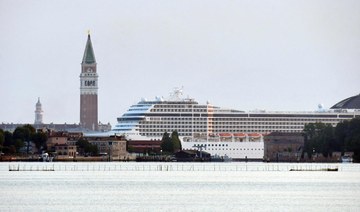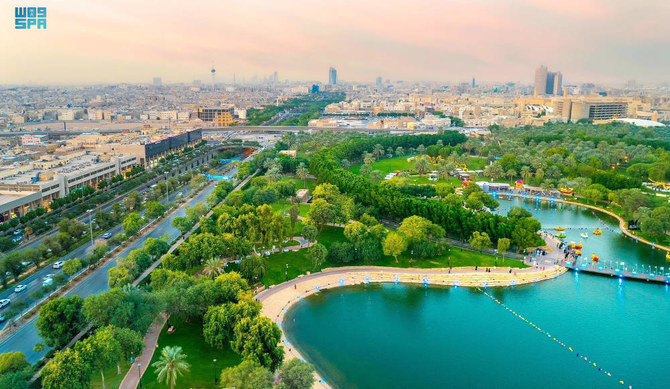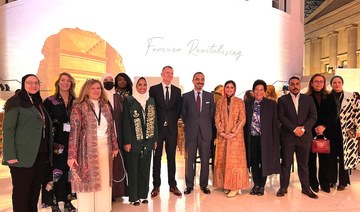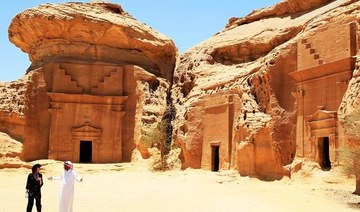ROME: Declaring Venice’s waterways a “national monument,” Italy is banning mammoth cruise liners from sailing into the lagoon city, which risked being declared an imperiled world heritage site by the United Nations within days.
Culture Minister Dario Franceschini said the ban was urgently adopted at a Cabinet meeting Tuesday and will take effect Aug. 1. It applies to the lagoon basin near St. Mark’s Square and the Giudecca Canal, which is a major marine artery in Venice.
Franceschini said the government decided to act fast “to avoid the concrete risk” that the UN culture agency UNESCO would add Venice to its list of “world heritage in danger” after it meets later this week in Beijing.
The Cabinet decree also “establishes an unbreakable principle, by declaring the urban waterways of St. Mark’s Basin, St. Mark’s Canal and the Giudecca Canal a national monument,” the minister added.
Before the coronavirus pandemic severely curtailed international travel, cruise ships discharging thousands of day-trippers overwhelmed Venice and its delicate marine environment. Environmentalists and cultural heritage have battled for decades with business interests, since the cruise industry is a major source of revenue for the city.
UNESCO recommended last month placing Venice on the agency’s list of World Heritage in Danger sites.
The Italian government previously decided to ban the ships but without establishing so soon a date. But on Tuesday, the government “decided to impose a strong acceleration” to implementing the move given the looming UNESCO review, Franceschini said in a statement.
The ban applies to ships weighing more than 25,000 tons or longer than 180 meters (530 feet) or with other characteristics that would make them too polluting or overwhelming for Venice’s environment.
The Cabinet decree also establishes compensation mechanisms for navigation companies and others affected by the ban. Until a more suitable docking area can be established elsewhere in waters outside the heart of Venice, the government has approved creating at least four temporary docking sites near the industrial port of Marghera, located on the northwestern Adriatic Sea.
Italy to ban mammoth cruise ships from Venice as of Aug. 1
https://arab.news/v73s6
Italy to ban mammoth cruise ships from Venice as of Aug. 1

- Culture Minister said the ban was urgently adopted at a Cabinet meeting Tuesday and will take effect Aug. 1
- Government acted fast “to avoid the concrete risk” the UNESCO lists Venice to “world heritage in danger”
How the hospitality industry in Saudi Arabia is embracing environmental sustainability
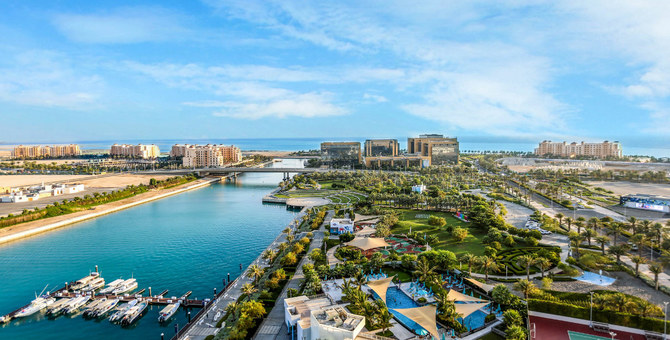
- From the Red Sea coast to Al-Ahsa Oasis, new eco-friendly hotels and resorts are opening across the Kingdom
- Industry leaders are boosting sustainability by cutting emissions, protecting habitats, and creating jobs locally
RIYADH: Saudi Arabia is emerging as a hotspot for international investment. Its latest hook? Sustainable hospitality.
The Kingdom led the Middle East and Africa’s hotel-building activity in 2023, with 42,033 hotel rooms constructed. This accounted for 35.1 percent of the 119,505 built in the region over the year, according to data from hotel monitoring firm STR.
Saudi Arabia’s hotel segment is projected to generate $2.51 billion in revenue this year and is expected to reach $3.02 billion by 2027, according to Statista.
One of the Kingdom’s Vision 2030 goals is to champion sustainability across all sectors, and in turn, hotels and plazas across the country have been working to implement more environmental and eco-friendly practices in their facilities.
From 2010 to 2019, Saudi Arabia’s tourism industry has contributed an average of 6.4 percent to the country’s gross domestic product, while recording a decline in greenhouse gas emissions.
In contrast, the global GDP average for travel and tourism over the same period rose 4.3 percent, and emissions by 2.5 percent.
Several of Red Sea Global’s developments are already up and running along the Kingdom’s northwestern coastline, including the Six Senses Southern Dunes, The Red Sea and St. Regis Red Sea Resort.
The company recently announced further projects pillared by environmental sustainability.
The Four Seasons luxury wellness resort, Amaala, Triple Bay, is branded with regeneration and wellness at its core, and is set to feature a one-of-a-kind Corallium marine life institute.
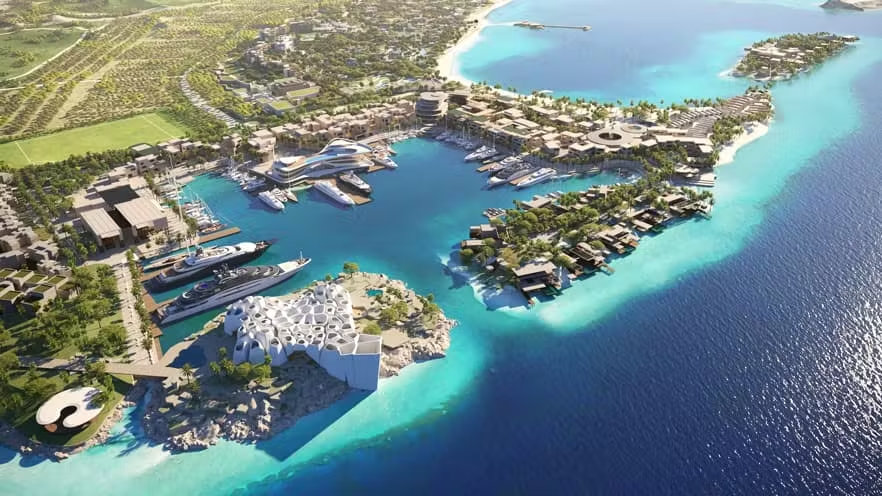
Progress is also being made on a sustainability-focused staff village that will provide housing for those who work at the resort. RSG says that five international operator brands, including Six Senses and Clinique La Prairie, are expected to be confirmed in the coming months.
“Our mission to develop new destinations as beacons of responsible tourism, showcasing the best in sustainable and regenerative development, gains unprecedented urgency as our planet continues to face challenges in relation to the climate crisis and biodiversity loss,” John Pagano, RSG’s group CEO, said in a statement.
The economic zone NEOM recently unveiled three new sustainable hotels in its Leyja oasis, including three flagship Habitas properties, as well as Zardun, a sanctuary resort designed to harmonize with the surrounding ecosystem.
NEOM’s Hotel Development division has also sponsored Hotelschool The Hague to bring about the Sustainable Hospitality Challenge, bolstering a new generation of innovation in the industry.
Many of the resorts across Saudi Arabia are built to blend in with the surrounding environment. Take AlUla’s Habitas, for example, which boasts the city’s serene desert landscape that immerses guests in its untouched backdrop.
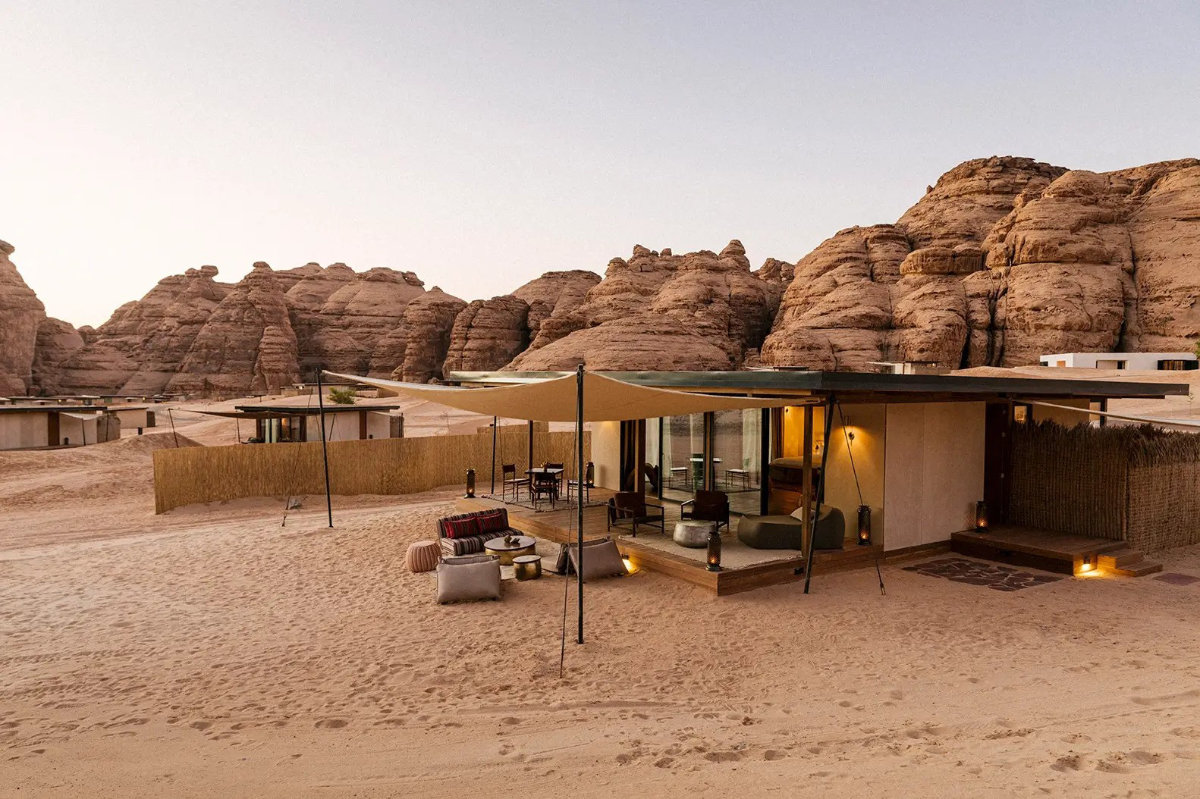
The luxury resort brand demonstrates its sustainable ethos, in line with the UN Sustainable Development Goals for 2030, through the offsetting of carbon emissions, waste management and a single-use plastic free policy.
“The AlUla Sustainability Charter is at the core of every hospitality project we develop within the destination,” Phillip Jones, chief tourism officer at the Royal Commission for AlUla, told Arab News.
“From the foundational design and materials of construction to the infrastructure, and the ongoing operations, as we only work with international operators that have a proven track record in sustainability, AlUla’s hotels and resorts each contribute toward delivering on our goals, such as achieving net carbon neutrality for local emissions by 2035.”
As the Arab region demonstrates overall lower environmental sustainability due to water scarcity, harsh climate and biodiversity threats, industry leaders are redefining the buzz term to fit local standards.
There are a number of grassroots projects that examine the existing traces of environmental sustainability awareness throughout the Arab region’s history. The Kingdom’s forefathers exhibited community-centered lifestyles, for example, while Islam advises its followers to conserve food and water consumption.
Chris Nader, CEO and co-founder of luxury ecolodge brand and management company ENVI Lodges, told Arab News: “Sustainability comes from a basis of trying to minimize our negative impacts on the environment. It’s not only nature, or animals — it’s also people.”
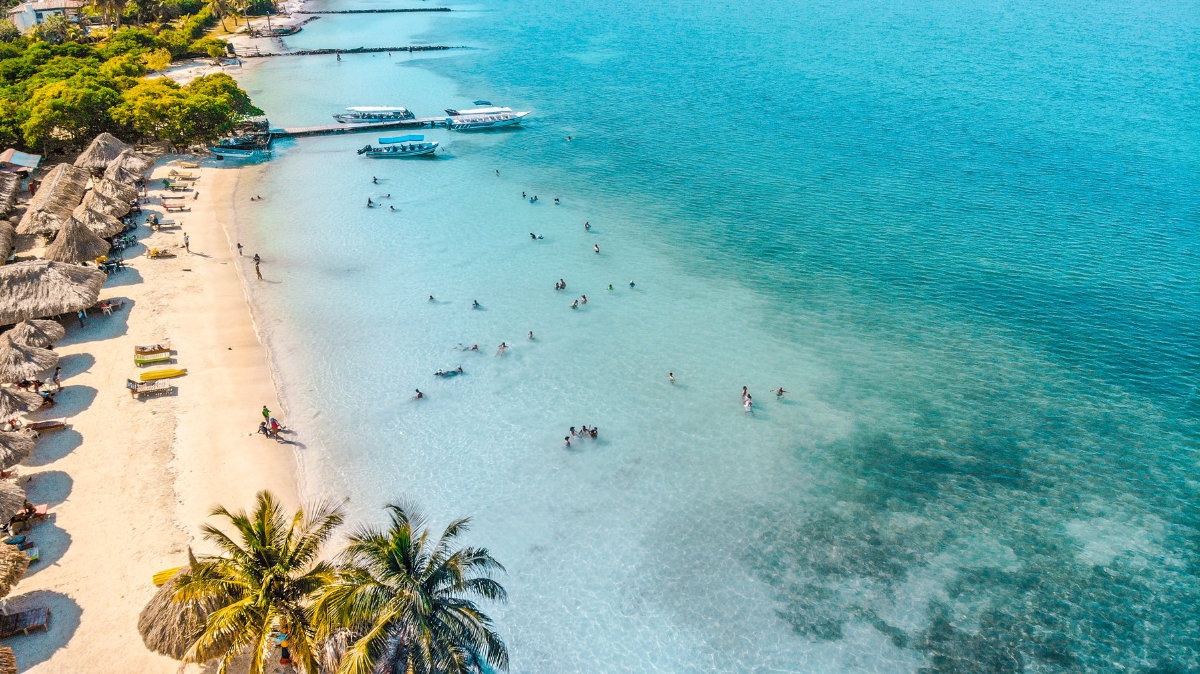
ENVI Laguna Bay, a sustainable project developed by Al-Rasim Hotels and Resorts, will occupy a prime Red Sea coast beachfront destination in King Abdullah Economic City, surrounded by mangroves.
“KAEC will host the first eco-friendly coastal resort in the distinguished and captivating laguna area,” Aiad Mushaikh, CEO of Al-Rasim Hotels and Resorts, said in a statement.
The project strongly aligns with Saudi Arabia’s Vision 2030. Its road map for tourism sector growth includes respecting the land, protecting wildlife, supporting local communities, sourcing mindfully, in-house food production, engaging guests and designing a sense of place. These pillars have been built into the technical guidelines of building the lodge.
One common belief is that building necessitates the destruction of land. But through its design principles, ENVI demonstrates different approaches that can be taken to minimize its presence within the natural landscape. The company builds low-impact lodges that blend into the environment.
“We don’t do excavations,” said Nader. “We put our unit on stilts or decks, and we don’t build the units completely on the site so the amount of people and trucks on the site that have to come and go is very limited.”
An important element is also selecting materials from the environment, whether they be wood, rocks or mud, and sourcing materials and products that will maintain durability and integrity over time.
OPINION
Islamic thinking carries a long tradition of sustainability — the Qur’an contains around 200 verses addressing environmental matters, writes Rodrigo Tavares. Click here to read his opinion piece.
The company also champions sourcing a percentage of the ingredients used in its kitchens from in-house gardens, developing programs for wildlife protection and hiring staff from local communities, all of which are tailor-made programs for each lodge.
The whole concept is to assume the project is temporary, aiming to leave the landscape more or less in the same state it was found in. The walkways are not poured concrete, and the native species are planted to cross-pollinate.
Another way to stitch sustainable practices within the fabric of the community is to engage guests in the initiative.
“Today, guests don’t want to be spectators,” said Nader. “They don’t want to be told that the lodge is planting mangroves. They want to plant themselves. Guests want to clean the beach, or the lodges, to remove any litter and plastic and all of that. They want to be involved in saving wildlife and caring.”
Saudi Arabia’s Public Investment Fund recently launched Dan Company, which specializes in agritourism and ecotourism. Architecture and design practice LWK + Partners is working on a project with Dan Co. that aims to invigorate the agriculture industry in Al-Ahsa through hospitality, serving as a benchmark for future projects.
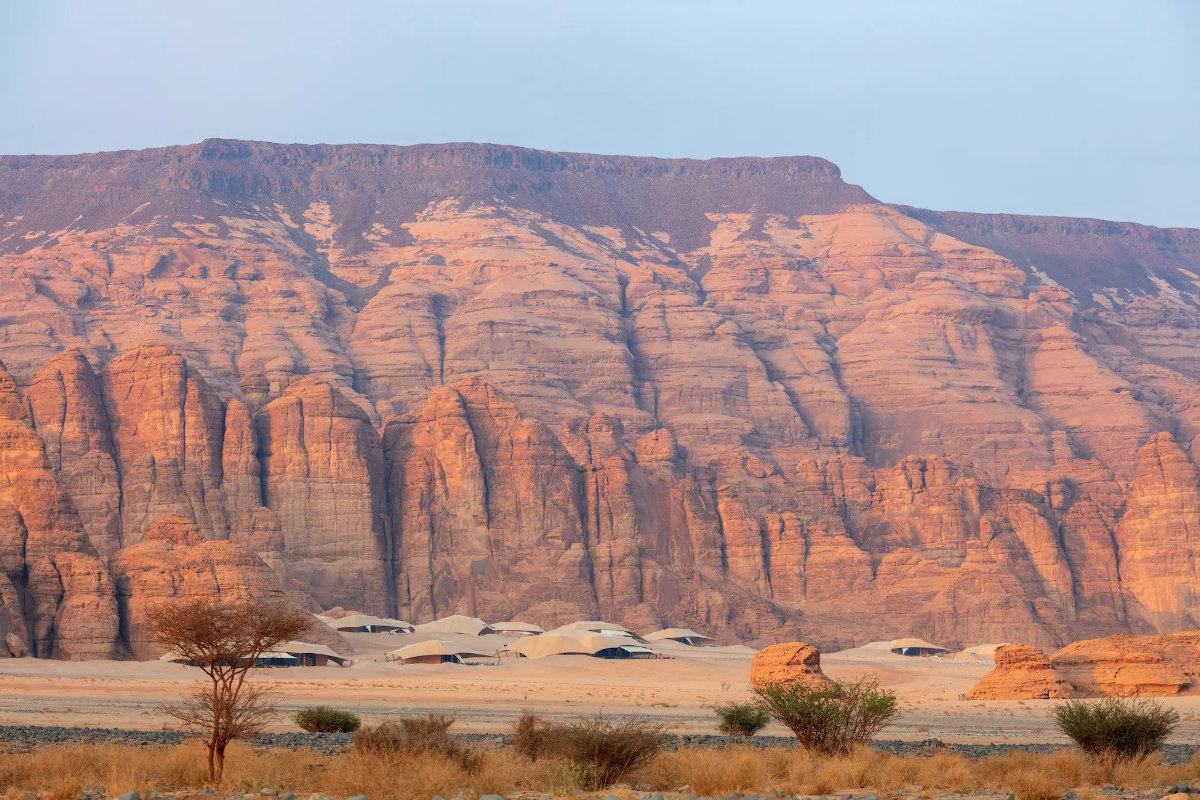
Kerem Cengiz, MENA managing director at LWK + Partners, told Arab News: “Sustainability isn’t just about the reduction of energy; sustainability is also about the way we create places that are harmoniously designed to make the way we interact with them sustainable.
“We look at sustainability as a holistic offering, rather than a series of tick boxes that we need to achieve.
“It really is important that when we design, we don’t have a pattern book; it still saddens me that we’ve seen many buildings going up that are just glass towers. They express a certain language and vision, but are they desirable in the context of the challenges that we’re facing environmentally?”
He added that the key to bridging these sustainable values into the future of the industry is to focus on a fundamental understanding of technology and innovation. How do you put in sensors that turn off the AC when guests leave the room, for example?
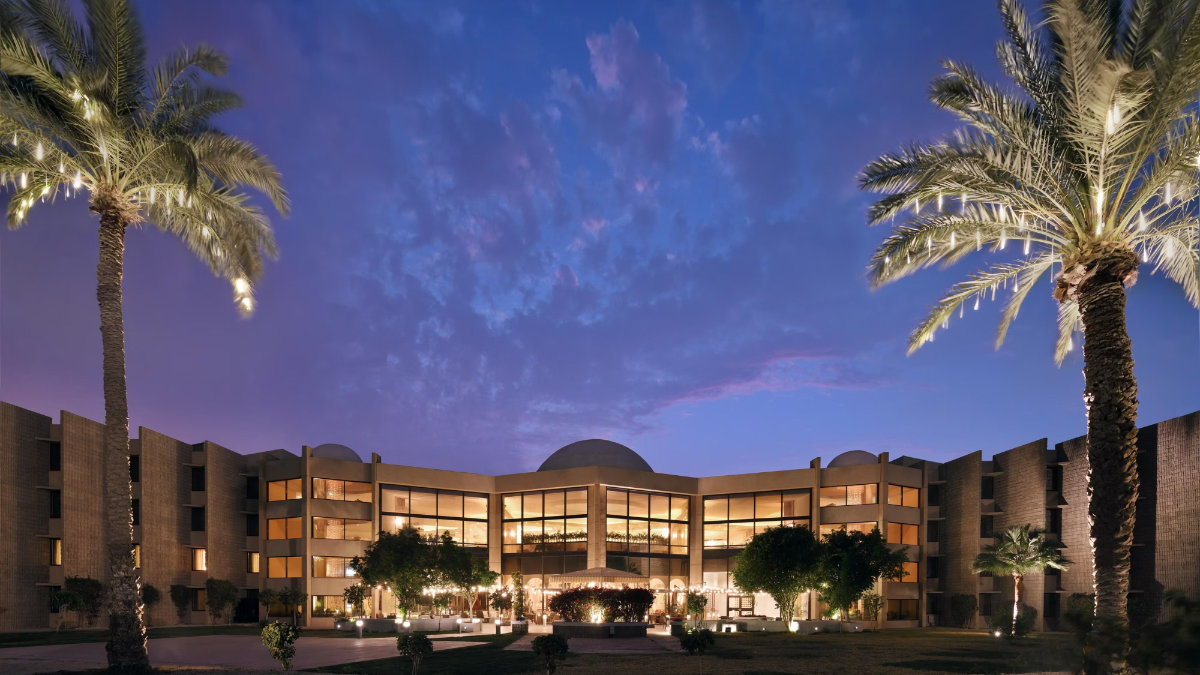
Saudi Arabia is leading the way in many development practices, said Cengiz. The Holiday Inn Tabuk is utilizing solar energy as an alternative power source in some locations, while the InterContinental Jubail carries out voluntary campaigns to clean its beaches.
Like Nader, Cengiz said that private and public developers should move towards sourcing materials that are locally or regionally available. This adds great value not only economically, but also sustainably, by cutting down on products imported from overseas, simultaneously reducing carbon emissions.
He added: “Now, Saudi is developing its own market and its own product lines. I think that, in itself, has a massive impact and I would love to see more attention on that type of thing.
“I think we’re way past the 2030 Vision now. I mean, we’re evolving it much further into something significantly more impactful.”
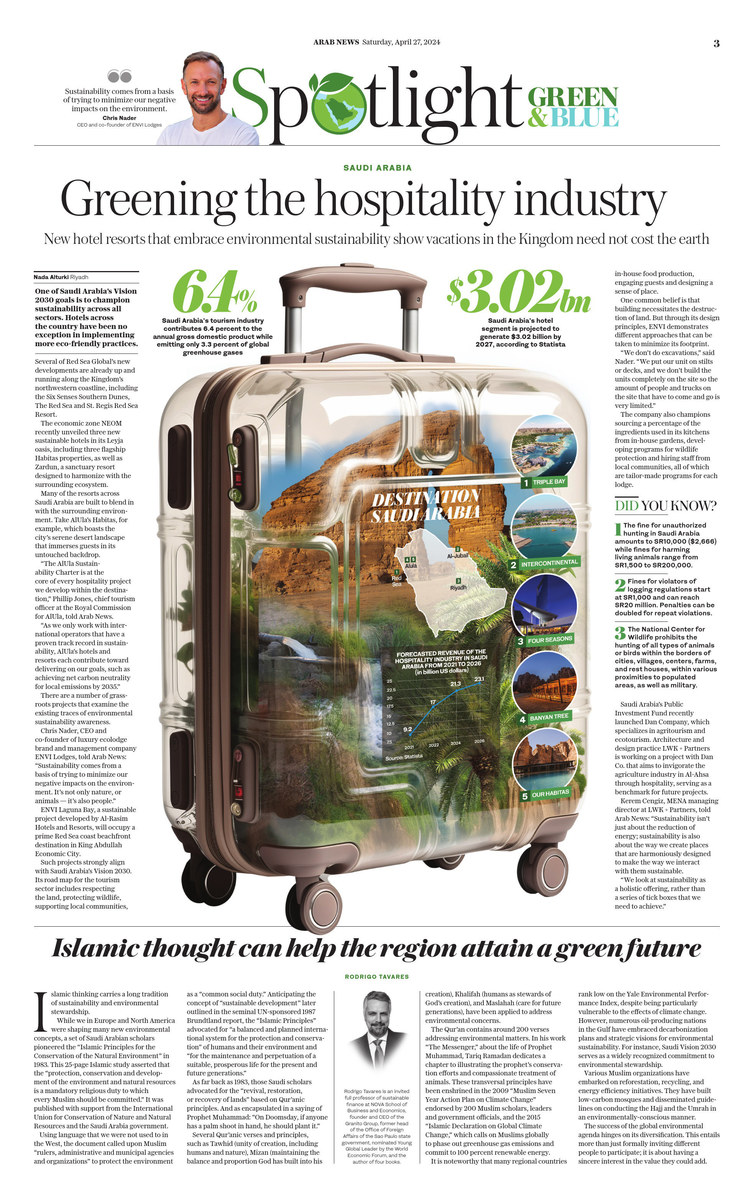
Two Saudi hotels listed in Conde Nast’s Hot List of new openings from the last year
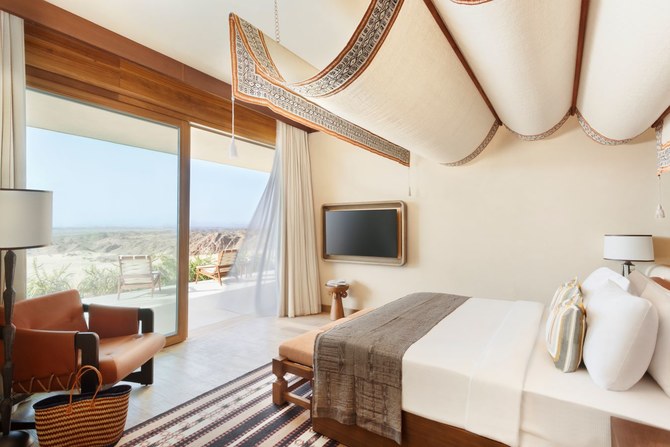
DUBAI: For those planning their next staycation, two hotels in Saudi Arabia have found a spot in Conde Nast’s prestigious annual Hot List, with one of them located in the heart of Riyadh.
The St Regis Riyadh and Six Senses Southern Dunes, The Red Sea have joined the list of best hotel openings from the last year, spanning the globe, from Argentina and Zimbabwe to Nepal and Spain, and more.
The St Regis Riyadh is “the only hotel inside Via Riyadh – a bijou mall of designer boutiques, hand-picked restaurants, and a cinema complex, wrapped within monumental sandstone walls at the edge of the Saudi capital’s Diplomatic Quarter – the St Regis Riyadh nods to the hotel brand’s New York heritage as well as its new Saudi home,” according to the publication.

Meanwhile, the new Six Senses Southern Dunes, The Red Sea, is the first resort to open in the 28,000-square-kilometer expanse of sea, reefs, islands and inland desert known, simply, as The Red Sea. It’s one of Saudi Arabia’s ambitious tourism-focused giga-projects, part of the Kingdom’s Vision 2030 aimed at diversifying the economy and heralding a new future for the nation.
Eid escapes: A guide to relaxing holiday destinations in the Kingdom
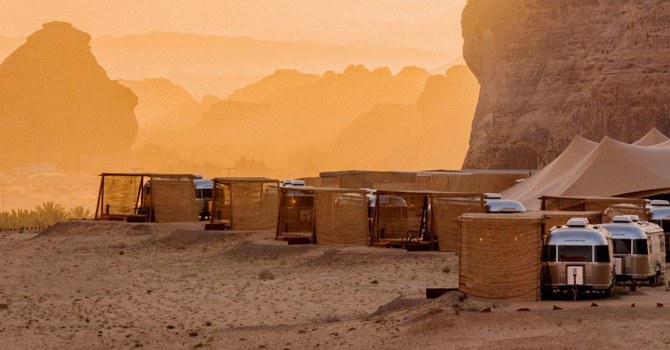
- Saudi Arabia’s diverse landscapes beckon adventurers to explore its natural wonders
- Saudi Arabia’s renowned tourism project, The Red Sea, is welcoming guests with the opening of The St. Regis Red Sea Resort
JEDDAH: After a month of worship, many people during Eid Al-Fitr break seek fun and relaxation. For those looking for a serene and rejuvenating destination, Saudi Arabia offers an array of options. From luxury resorts to sustainable desert getaways, the Kingdom provides diverse choices to suit all preferences.
Here is a curated list of destinations for a perfect Eid getaway.
The St. Regis Red Sea Resort
Saudi Arabia’s renowned tourism project, The Red Sea, is welcoming guests with the opening of The St. Regis Red Sea Resort. Situated on the Ummahat Islands in the Al-Wajh Lagoon, this luxurious resort features 90 beachfront and overwater villas, each boasting private pools and stunning views. Designed by architect Kengo Kuma, the resort’s aesthetic reflects the beauty of coral reefs and dunes. Guests can dine al fresco at five beachside venues and enjoy Japanese-inspired cuisine at Gishiki 45 and Tilina. The resort offers a spa, gym, and outdoor lap pool, all powered by renewable energy. Rates start from $1,866 per night.
Six Senses Southern Dunes
Nestled amid rolling dunes and the Hijaz Mountains, Six Senses Southern Dunes offers a unique retreat. With rooms, suites, and villas designed under tent-like roofs, the resort blends modern luxury with traditional charm. Guests can enjoy spacious accommodations with outdoor terraces and private pools. The resort’s spa spans 4,000 square feet and offers a range of treatments. Activities include cooking classes and fishing tours, and dining options cater to diverse palates. Rates start from SR4,380 ($1,168) for a Wadi King Room, with a commitment to sustainability.
AlUla: A haven of history and natural beauty
Located in the northwest of Saudi Arabia, AlUla is renowned for its rich history, stunning landscapes, and archaeological wonders. Home to UNESCO World Heritage Sites like the Nabatean tombs at Hegra and ancient rock art, AlUla offers visitors a glimpse into ancient civilizations. The region is undergoing extensive development to enhance its tourism infrastructure while preserving its cultural heritage and natural beauty.
Here are some top accommodations in AlUla for an unforgettable Eid escape experience:
Habitas AlUla: A sustainable desert resort offering luxury accommodations amid the desert canyons of the Ashar Valley, Habitas AlUla features 96 guest villas, each designed to blend seamlessly with the surrounding landscape. Guests can enjoy a range of facilities, including wellness centers, dining options, and a large infinity swimming pool.
Caravan by Habitas AlUla: Caravan provides a unique luxury camping experience in the picturesque Ashar Valley with exclusive Airstream trailers offering either an oasis or mountainous view. Each of the 22 deluxe trailers features panoramic views, air conditioning, WiFi, a queen-size bed (or two single beds), an indoor lounge, a kitchenette, and a private shower and bathroom. Prices range from SR1500 to SR2500 per night.
Ashar Tented Resort: Nestled amid the sweeping desert sands and rugged rock formations of the Ashar Valley, this luxury camping experience immerses guests in AlUla’s spectacular scenery. With access to five-star facilities at the neighboring Banyan Tree Hotel, guests can enjoy a comfortable and memorable stay.
Banyan Tree AlUla: Offering breathtaking views of the Ashar Valley, Banyan Tree AlUla features 47 elegant tented villas adorned with authentic Arabian-inspired details. Committed to sustainability and well-being, the resort advocates for environmental conservation and cultural preservation.
Whether you seek luxury, tranquility, or cultural immersion, AlUla offers a range of experiences to suit every traveler’s preference.
Explore the region’s rich history, breathtaking landscapes, and unparalleled hospitality for an unforgettable Eid getaway: www.experiencealula.com.
Adventures and sightseeing
Many seek the perfect getaway to unwind and connect with nature. In Saudi Arabia, adventure-seekers have a plethora of options thanks to the diverse terrains that span the Kingdom. From sandy deserts to rugged mountains and lush valleys, there is something for everyone to explore.
Guiding adventurers across the Kingdom
Saudi Trips, a leading adventure agency, offers a range of trips and hikes across the Kingdom. Founded by Ibrahim Saad, the agency aims to provide visitors with the best Eid experience, tailored to their preferences and budget.
Saad highlights some of the prime camping and hiking spots, including the iconic AlUla region, the mysterious Dark Cave in Tabuk, and the picturesque Wadi Al-Disah in Jazan.
“In my opinion, the best destinations during Eid break are the sandy areas, caves, and valleys,” Saad told Arab News. “Activities vary according to the terrain, including walking on the sand, mountain climbing, and descending.”
Other notable destinations Saad mentioned include Lajab Valley, the Caravans Trail along the Tuwaiq Mountains, Thumama, and Mount Qarah in the Eastern Province.
Happy escape
For those seeking a unique experience, Ahway, a Saudi tourism project, offers well-equipped caravans in scenic locations. Founded by Saeed Azhar, Ahway aims to promote local tourism while providing visitors with a chance to disconnect from city life and immerse themselves in nature. Starting in Taif, the project plans to expand to other regions like AlUla and Tabuk, offering guests a chance to explore Saudi Arabia’s stunning landscapes.
Diverse landscapes
Khalid Al-Rabiah, CEO of Ghamra Adventures Agency, spoke to Arab News about the allure of Saudi Arabia’s diverse landscapes during Eid.
“Being in a large city like Riyadh, the nearby areas, especially Thadiq National Park and the dunes and valleys of Rughabah Village, are considered prime destinations for Eid escape, especially with their unique nature and the presence of hiking trails and mountain ridges spanning over 70 km.
“There is also a growing trend of camping in the unique natural environments of Hail and Tabuk, known for their peculiar mountains with strange formations and golden sands.”
Ali Al-Abdali, a tour guide in Jazan, describes the region as a haven for hiking and wilderness enthusiasts not only for the Eid holiday but throughout the year.
From stunning beaches along the Red Sea to rugged mountains like Al-Ardah and Al-Rayth, Jazan offers diverse landscapes for outdoor activities.
As Eid approaches, Saudi Arabia’s natural attractions beckon adventurers, both local and international, to explore and create unforgettable memories amid breathtaking scenery.
Bulgaria, Romania take first steps into Europe’s visa-free zone

- New status will not apply to land routes, after Austria veto over fears of a potential influx of asylum seekers
- Schengen zone will now comprise 29 members, including 25 EU member states plus Switzerland, Norway, Iceland and Liechtenstein
BUCHAREST: Bulgaria and Romania joined Europe’s vast Schengen area of free movement on Sunday, opening up travel by air and sea without border checks after a 13-year wait.
A veto by Austria, however, means the new status will not apply to land routes, after Vienna expressed concerns over a potential influx of asylum seekers.
Despite the partial membership, the lifting of controls at the two countries’ air and sea borders is of significant symbolic value.
Admission to Schengen is an “important milestone” for Bulgaria and Romania, symbolizing a “question of dignity, of belonging to the European Union,” according to foreign policy analyst Stefan Popescu.
“Any Romanian who had to walk down a lane separate from other European citizens felt being treated differently,” he told AFP.
Ivan Petrov, a 35-year-old Bulgarian marketing executive who lives in France, said he was enthusiastic about less stressful traveling and the time he would be able to save.
“This is a great success for both countries, and a historic moment for the Schengen area — the largest area of free movement in the world,” EU chief Ursula von der Leyen said in a statement Saturday.
“Together, we are building a stronger, more united Europe for all our citizens.”
With Bulgaria and Romania arriving joining Sunday, the Schengen zone will comprise 29 members — 25 of the 27 European Union member states as well as Switzerland, Norway, Iceland and Liechtenstein.
Romania’s government said Schengen rules would apply to four sea ports and 17 airports, with the country’s Otopeni airport near the capital Bucharest serving as the biggest hub for Schengen flights.
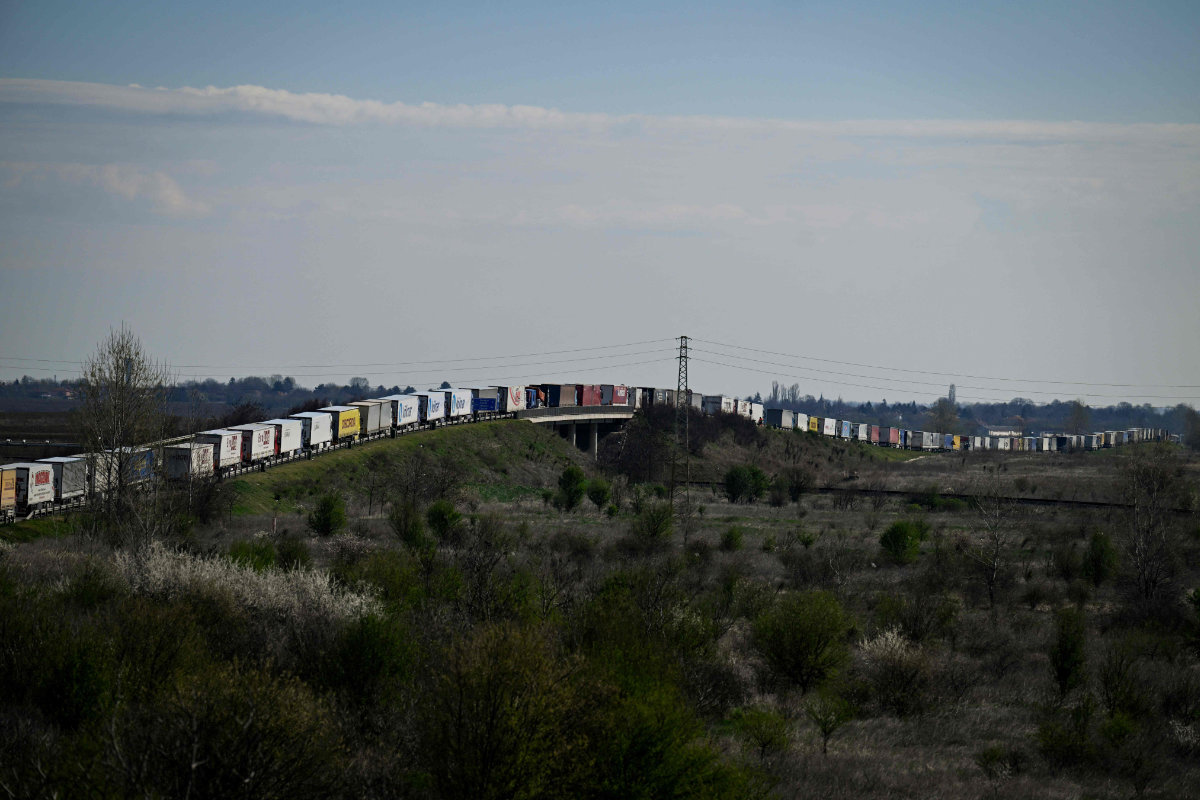
More staff including border police and immigration officers will be deployed to airports to “support passengers and detect those who want to take advantage to leave Romania illegally,” it added.
Random checks will also be carried out to catch people with false documents and to combat human trafficking.
Bulgaria and Romania both hope to fully integrate into Schengen by the end of the year, but Austria has so far relented only on air and sea routes.
Croatia, which joined the EU after Romania and Bulgaria, beat them to becoming Schengen’s 27th member in January 2023.
Created in 1985, the Schengen area allows more than 400 million people to travel freely without internal border controls.
While some have reason to celebrate, truck drivers, faced with endless queues at the borders with their European neighbors, feel left out.
Earlier this month, one of Romania’s main road transport unions the UNTRR called for “urgent measures” to get full Schengen integration, deploring the huge financial losses caused by the long waits.
“Romanian hauliers have lost billions of euros every year, just because of long waiting times at borders,” secretary general Radu Dinescu said.
According to the union, truckers usually wait eight to 16 hours at the border with Hungary, and from 20 to 30 hours at the Bulgarian border, with peaks of three days.
Bulgarian businesses have also voiced their anger over the slow progress.
“Only three percent of Bulgarian goods are transported by air and sea, the remaining 97 percent by land,” said Vasil Velev, president of the Bulgarian Industrial Capital Association (BICA).
“So we’re at three percent in Schengen and we don’t know when we’ll be there with the other 97 percent,” he told AFP.
Bucharest and Sofia have both said that there will be no going back.
“There is no doubt that this process is irreversible,” Romanian Interior Minister Catalin Predoiu said this month, adding it “must be completed by 2024 with the extension to land borders.”
Georgina Rodriguez, Cristiano Ronaldo explore Red Sea coast in Saudi Arabia

DUBAI: Football star Cristiano Ronaldo and his partner, Argentinian model Georgina Rodriguez, are on a mission to explore Saudi Arabia — their most recent excursion was a visit to the Kingdom’s coastline, which the model shared on social media.
“Love in paradise. We keep discovering Saudi Arabia,” Rodriguez posted from a Red Sea resort, while tagging @VisitSaudi, the official tourism account of Saudi Arabia. The photographs include shots of the couple and their children enjoying a day at the beach before posing for a photograph on an overwater deck.
The Al-Nassr footballer often uses his downtime to explore the country and was spotted in AlUla in December.
“Amazed by the extraordinary human and natural heritage of AlUla here in Saudi Arabia,” he wrote on Instagram at the time.
The couple enjoyed a romantic dinner and visited AlUla’s Maraya, a multi-purpose venue that holds the Guinness World Record as the largest mirrored building with 9,740 glass panels. It is located 12 km from Saudi Arabia’s first UNESCO World Heritage site, Hegra.
Rodriguez has also been enjoying Saudi Arabia’s social scene without her famous partner —earlier in March she was seen at an event hosted by Saudi perfume label Laverne in Riyadh.
The Netflix star, who has her own reality show titled “I Am Georgina,” took control of the brand’s Snapchat account, offering followers an exclusive glimpse into her experience at the event.
In March 2023, Rodriguez collaborated with the brand on a campaign — and she answers candid questions about her time in the Kingdom in the new clip.
“I feel very safe in this country and really appreciate its family values,” she said in the stylish video posted on social media at the time.



